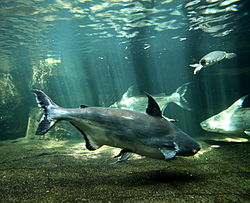Conservation
This fish is highly protected and has a high conservation value and is banned from being fished through all seasons. [20] The fish is being threatened by overharvesting, damming of rivers, and pollution. Their population continues to decline as there are not many legislations and enforcement toward this species. A common threat to these large organisms is dams and segmentation of the Mekong River. The Paroon shark travels upstream to spawn and resides downstream. The construction of dams leads to segmentation of the natural habitat, preventing their migration up and down the river. [21] [22] Even though the bodies of water are interconnected these fish are not capable of swimming through walls to get to their natural breeding sites.
To control the amount of overharvesting (via fishing) that occurs certain size and catch limits can be put in place. In 1989, the Paroon shark was listed as a class II protected species by the government of Yunnan, China. [11] The issue is that the habitat of this species lies in multiple countries' domains including Cambodia, Lao People's Democratic Republic, Thailand, and Viet Nam. Restrictions in parts of the river that reside in China's territory, leave the other parts to be unprotected.
A known breeding practice, to try and help the population, is being practiced by the Thai government. [8] A halt on harvesting has been recommended until P. sanitwongsei's population can rise to a safe level. [8] Even though these fish are grown in a safe fishery, this can reduce the genetic diversity between them making them more susceptible to disease as well as environmental stress.
There are some groups in the Asian continent who have been trying to protect and conserve the wildlife in these regions including the Asian Species Action Partnership (ASAP), World Wildlife Fund (WWF), and the Species Survival Commission (SSC), part of the International Union for the Conservation of Nature (IUCN). [23]
The giant pangasius is considered an umbrella species in conservation. Protecting this species would provide protection for species that inhabit the same region. With this tactic, a whole ecosystem can be preserved. Due to this area being an area that is highly fished commercially and locally, certain regulations can be put in place to manage the size of the fish that can be caught allowing mature adults to reproduce with greater success. [24]







